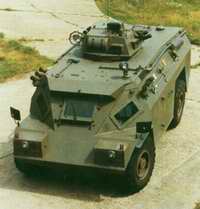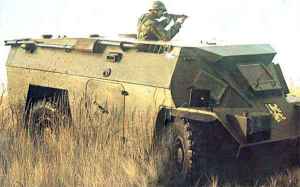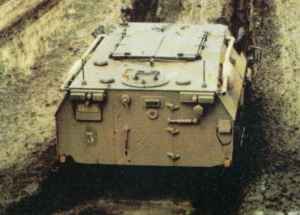| Designation: | BDX |
 |
|---|---|---|
| Manufacturer: | BDX Beherman Demoen Engineering | |
| Product type: | Armoured Vehicles | |
| Name: | Wheeled armoured personnel carrier |
In 1976, the Engineering Division of Beherman Demoen negotiated successfully with the Irish company Technology Investments Limited for a licence to produce an improved version of the Timoney (4 × 4) armoured personnel carrier.
The first production order for the BDX was awarded by the Belgian government in 1977 and called for the delivery of 43 vehicles to the Belgian Air Force for airfield protection duties and 80 vehicles to the Belgian Gendarmerie.
The vehicles for the air force were armed with a ring-mounted 7.62 mm light machine gun. The gendarmerie order consisted of 41 APCs without a turret, 26 vehicles with a dozer blade for clearing obstacles and 13 vehicles fitted with an 81 mm mortar in the rear of the hull. First production vehicles were completed late in 1978 and production was completed for the Belgian government in February 1981.
BDX delivered five vehicles to Argentina and the vehicle was also demonstrated to a number of other countries including Indonesia and Malaysia.
Beherman Demoen Engineering (BDX) is no longer involved in the design, development or production of armoured vehicles.
According to United Nations arms transfer list, Mexico took delivery of 95 vehicles in 1994. This left a total of 28 vehicles remaining in Belgium.
Early in 2001, following an international competition, the Australian Tenix Defence Systems S600 (4 × 4) internal security vehicle was selected to meet the requirements of the Belgian Gendarmerie.
Recent information has indicated that a total of 152 BDX vehicles were built. The above figures quote a total of 128 vehicles thus indicating additional export sales to other undisclosed countries.
The Mexican BDX (4 × 4) APC has the local designation of the DNC-2. The Belgian-supplied AMX-VTT has the local designation of the DNC-1. These serve alongside a fleet of locally built 4 × 4 APCs, which are covered in a separate entry. These were delivered to Mexico between 1993 and 1994.
The hull of the BDX is made of all-welded steel, which varies in thickness from 9.5 to 12.7 mm and provides complete protection against 5.56 and 7.62 mm armour-piercing projectiles fired at point-blank range and splinters from 105 mm artillery projectiles exploding on the ground 10 m from the vehicle. The BDX will withstand the blast from a 9 kg anti-tank mine exploding 10 m from the vehicle.
The driver sits at the front of the hull in a central position and has three windscreens, one in front and one on either side, made of multiplex glass 81 mm thick which provides the same level of protection as the rest of the hull. The large front windscreen has a wiper and can be hinged forward for improved ventilation in a non-combat area.
The crew enters and leaves the BDX by three doors, one in each side of the hull and one at the rear. All the doors open through a full 180° and can be locked half open if required. Ball mounts with vision blocks are provided in each side of the hull to the rear of the side entrance door and in the rear door.
The 10 infantrymen have individual seats with waist seatbelts. The interior of the hull is padded to reduce both noise and the internal temperature of the vehicle.
The Chrysler V-8 engine is mounted to the immediate rear of the driver and is coupled to an Allison automatic transmission, which in turn provides power to the transfer box at the back of the vehicle. This transmits power to the front and rear axles by a propeller shaft. Both front and rear axles are equipped with a self-locking differential of the 'no-spin' type. The air inlet and air outlet louvres are in the roof over the driver's position with the air outlet louvres located either side of the engine compartment in the roof. Protection against Molotov cocktails could be fitted if required. The exhaust pipes run along the outside of the hull.
The 7.62 mm machine gun turret is fitted on the roof of the BDX to the rear of the engine compartment and a further circular hatch cover is provided in the roof at the rear. The vehicle, when fitted with the 81 mm mortar, has two rectangular hatches in the roof that open either side of the hull.
The BDX is fully amphibious and propelled in the water by its wheels. Optionally, two water-jets could be fitted to increase its water speed.
Optional equipment includes an air conditioning system, a front-mounted dozer blade for clearing obstacles, a heater, an NBC system and hull-mounted smoke grenade dischargers.
In addition to being used as an armoured personnel carrier, the BDX could be used for a wide range of other roles such as an ambulance, command vehicle and reconnaissance vehicle. Apart from the version with an 81 mm mortar, none of these specialised versions of the BDX were ever placed in quantity production. Argentine BDX
A total of five vehicles were purchased in 1980, four in APC configuration and one in command post role. These are used by Federal police and are fitted with a locally developed 38.1 Venturini multiple rail grenade launcher on vehicle roof at front right side. Vickers Valkyr APC
This is a further development of the BDX but never entered production and is no longer marketed.
|
||||||||||||||||||||||||||||||||||
|
||||||||||||||||||
 |
 |
 |
 |
 |
 |



